Japan
Wood Products Prices
Dollar Exchange Rates of 25th
March
2021
Japan Yen 109.82
Reports From Japan
State of emergency lifted
across country
On 21 March the Japanese government announced an end
to the current state of emergency in the Tokyo region as
the rate of corona infections had declined. This will bring
some relief to the stricken economy and lay the ground
work for preparations for this summer's Tokyo Olympics.
There is concern, however, that easing restrictions now
could result in a resurgence of infections. The spread of
the virus fell during the latest state of emergency but
recent data suggest the decline has bottomed out and is
even rebounding in some prefectures including Tokyo.
Bank of Japan confirms continuation of stimulus
policy
The Bank of Japan (BoJ) announced changes in its
approach to maintaining growth and at the same time
trying to generate inflation.
After the latest BoJ policy meeting the Bank governor said
they will aim to balance support for stimulus over the
longer term while avoiding the impression that the Bank is
cutting back on easing measures.
While leaving its main policy rates unchanged the bank
said the range of its 10-year bond yield would now be
plus/minus 0.25%. Until January the range had been
around 0.2%.
The Bank said it would offer lending incentives if it
lowered its target rates a move aimed at changing the
perception it cannot lower its negative rate due any further
without undermining the viability of struggling regional
banks.
At the end of last year prices in Japan fell sharply and this
made the Bank search for ways to keep its stimulus efforts
running for longer. Inflation still looks a long way off as
prices fell for a seventh consecutive month in February.
Machinery orders tilt lower
According to the Cabinet Office private-sector machinery
orders fell 4.5% in January compared to December 2020.
Machinery orders are seen as a leading indicator of capital
spending. The January decline was the first in four
months.
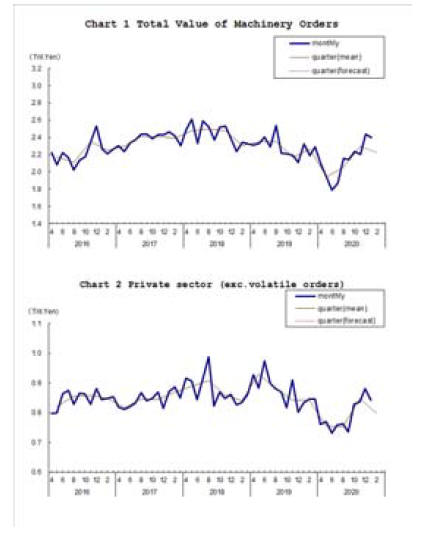
Companies rethinking overseas investment
strategies
A Japan External Trade Organization (JETRO) survey has
found that most Japanese companies which were
considering pursuing overseas operations are rethinking
business strategies and almost 70% of companies with
overseas operations said they had seen sales drop in fiscal
2020.
The survey found that 36% are concerned that over the
next two to three years China and the US will introduce
tough trade regulations which will dent global trade.
While the mood among firms looking to expand existing
overseas operations has fallen the JETRO survey says
there is still considerable interest among Japanese firms to
establish overseas operations.
Other points from the JETRO report include:
Business confidence fell to the lowest level due
to the COVID-19 pandemic, while deterioration
in China was mild.
The intention of business expansion in the next
one to two years is at a record low.
70% of Japanese affiliated companies in China
expect to recover from the negative impact of the
pandemic in the first half of 2021, earlier than
other countries.
COVID-19 accelerated the digital shift of
companies.
The negative impact of changes in the trading
environments lingers with significant
deterioration in Hong Kong and Australia.
In Vietnam changes in the trading environments
had a positive impact on business performance.
See:
https://www.jetro.go.jp/ext_images/_News/releases/2021/69b41fe59a5b2299/rp_firms_asia_oceania2020.pdf
Yen continues to weaken but this may not last
Following the Bank of Japan¡¯s decision to widen the target
range for the 10-year Japanese government bond yield the
yen weakened past 109 to the US dollar. This boosted
sentiment among exporters but analysts signaled the yen
has the capacity to recover some of its weakness as, at
present, it is starting to look increasingly cheap.
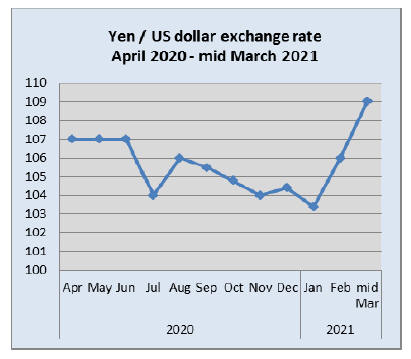
Residential housing oversupply
Data from the Land Institute of Japan suggests Japan's
housing market remains steady despite the economic
repercussions from the pandemic.
e index rose by
about 0.8% during the first three quarters of 2020
following year on year rises of 0.6% in 2019, 2.1% in
2018, and 2.4% in 2017.
However, residential construction activity continues to fall
due to the country's massive over-supply. In the first
eleven months of 2020 housing starts fell by 10%
following three consecutive years of declines.
Sales of existing detached house sales increased 3.6% in
the first three quarters of 2020 and it has been suggested
demand could rise after the pandemic as Japan is an
attractive investment destination for foreign buyers mainly
from Singapore, Malaysia, Thailand, Hong Kong, and
mainland China.
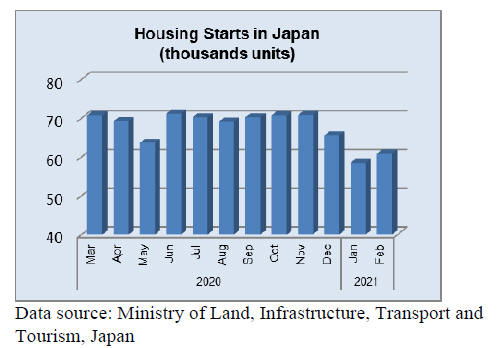
Import update
Furniture imports
Clearly the pandemic has been good for sales of kitchen
and bedroom furniture. Japan¡¯s imports of both items have
risen over the past 12 months with the value wooden
kitchen furniture import rising the most. This fits with the
observation that households have, during the various
lockdowns, turned their attention to home improvement.
The scale in the graphic below on wooden furniture
imports disguises the substantial increase in the value of
wooden office furniture which it can be assumed is linked
to the work-from-home style which created demand for
home office items (see graphic under office furniture).
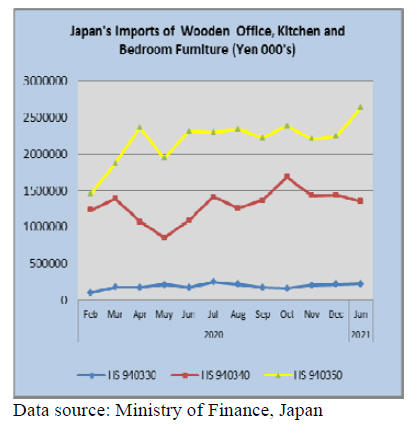
Office furniture imports (HS 940330)
The value of Japan¡¯s imports of wooden office furniture
(HS940330) rose 4% from a month earlier but year on
year the value of imports was down 9%.
Throughout last year shippers in China dominated the
supply of wooden office furniture to Japan and this
continued into 2021 with some 80% of all arrivals coming
from China. Polish wooden office furniture acouted for
5% od January imports and a new comer to the list of top
20 shippers, Vietnam, secured around 2% of the value of
January imports.
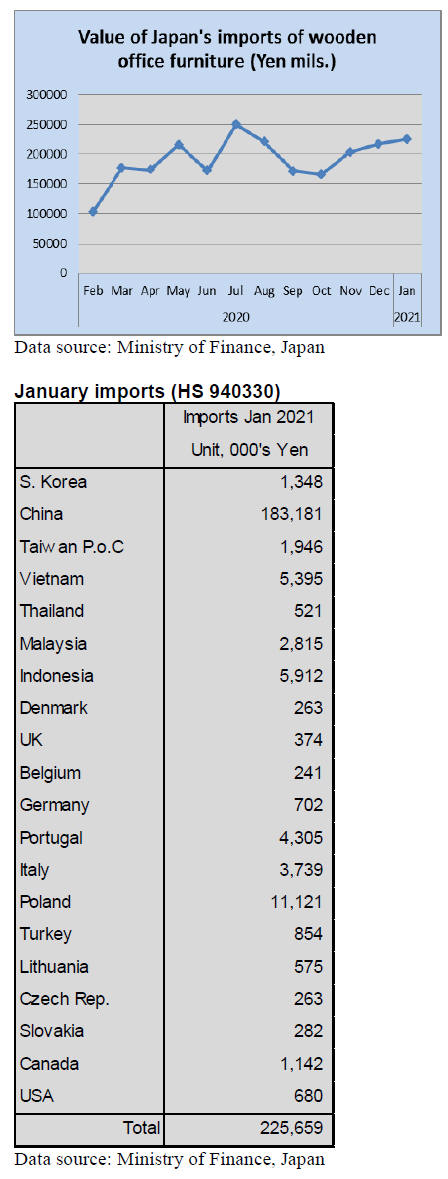
Kitchen furniture imports (HS 940340)
Consitently over the past year suppliers in three countries,
the Philippines, Vietnam and China accounted for most of
Japan¡¯s imports of wooden kitchen furniture, this
continued into January 2021 with shippers in Vietnam and
the Philippines accounting for almost 40% each of imports
with a furthet 13% coming from manufacturers in China.
Less than 5% was supplied from European makers.
Year on year the value of Japan¡¯s imports of wooden
kitchen furniture dropped 9% in January and compared to
arrivals in December 2020 there was a 6% decline in
January 2021.
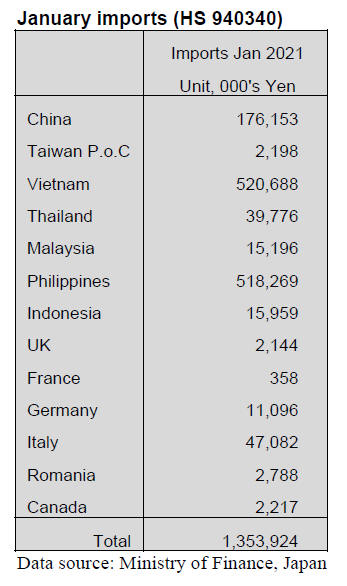
Bedroom furniture imports (HS 940350)
The value of Japan¡¯s January 2021 imports of wooden
bedroom furniture (HS940350) was up a massive 17%
compared to December 2020 imports. However, year on
year, January 2021 imports dipped around 7%.
China and Vietnam shipped wooden bedroom furniture
accounting for over 90% of the value of Japan¡¯s January
2021 imports. Manufacturers in Malaysia and Thailand
together contributed another 5% to the value of January
2021 import values.
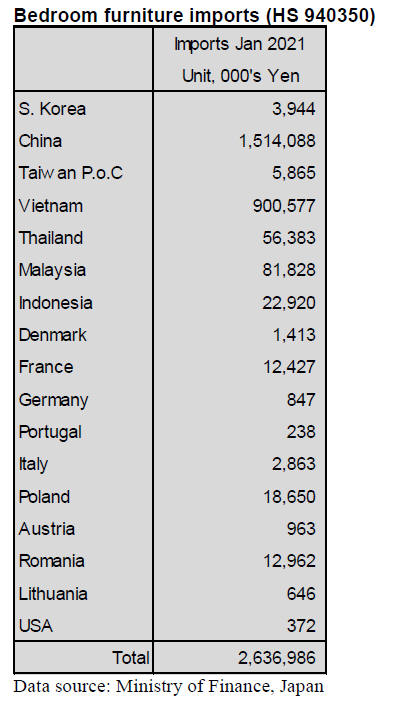
Trade news from the Japan Lumber Reports (JLR)
The Japan Lumber Reports (JLR), a subscription trade
journal published every two weeks in English, is
generously allowing the ITTO Tropical Timber Market
Report to reproduce news on the Japanese market
precisely as it appears in the JLR.
For the JLR report please see:
https://jfpj.jp/japan_lumber_reports/
Orders taken by major house builders
Average ordered values by eight major house builders in
January is 1% less than January last year, first decline after
three months.
Visitors to the house exhibition sites dropped after the
second state of emergency was declared but request of
advertising materials through web site doubled.
Demand for detached units seems to be increasing and
major house builders are establishing new marketing style.
Sending out marketing information to potential buyers
then first interview at model house at the exhibition site,
which leads to conclude the deal.
Sales value by other listed house builders has been
exceeding last year¡¯s record for nine straight months.
Inquiries are strong for suburban areas. Demand is active
to have house in suburban areas of Tokyo like Chiba and
Saitama prefecture where commuting is possible and can
have more spacious house.
Number of visitors to house exhibition sites had been
increasing since last fall until January but people are now
used to behave with COVID-19 prevention measures and
potential buyers are serious to act despite various
restrictions.
House builders have been introducing new models with
new specifications to cope with new life style after the
market is changing rapidly. Particularly having work space
at home is necessary to deal with demanding remote teleworks.
March is normally busy month for house buyers as it is
month of school graduation and transfer of working areas.
The state of emergency is now extended to March 21 and
after this is lifted, potential buyers get active.
Domestic log supply in 2020
At the beginning of 2020, housing starts were expected to
decline because of consumption tax increase in October
2019 so log demand would be less than 2019 then came
unexpected COVID-19 pandemic so the demand dropped
down to 2015 level..
Weather in January and February was very mild all over
Japan so that log production was smooth. Recent tendency
is that sawmills build up log inventory in the first half of
the year to prepare tight log supply in summer so log
purchase was active through March then in April, the state
of emergency was announced so log purchase slowed
down rapidly with uncertain future market.
In July, log shipment to sawmills was 28.6% down and to
veneer plants was 29.2% down and the log prices plunged
to record low level. After mills¡¯ log inventory started
decreasing, log purchase got active but log production did
not recover by heavy rain and low prices so by fall, log
prices took off and soared.
Log inventory at the end of the year was less than
December 2019. After all, sudden brake of log purchase in
the second quarter resulted in sharp drop of log prices then
decrease of log inventory and price escalation.
In 2020, domestic log shipment to sawmills was 11,550 M
cbms, 11.6% less than 2019 and to veneer and plywood
plants was 4,130,000 cbms, 8.3% less. Domestic log
shipment to sawmills was bottom in 2015 with 11,910,000
cbms when log prices dropped record low then it had
increased for four years since 2016 and it was 13,070,000
cbms. Reasons are construction of new large sawmills and
plywood mills assisted by the government subsidy and
shift to domestic logs after imported log cost increased.
Plywood
Movement of softwood plywood is getting quiet after
orders from wholesalers started decreasing since last
month and precutting plants show difference of demand by
how much orders they have from large builders. After all,
the market is not as active as last December and January.
Supply shortage problem is largely solved and in
particular, in Kanto and North, orders from heavy snow
area are slowing so generally, the supply becomes
smoothly now. In Western Japan, the supply is still tight as
some plywood mills experience lower production which is
normal in cold winter time. The market prices are stable
after the mills raised the sales prices.
The softwood plywood mills need to increase the prices
more because cedar log prices have been climbing after
January but with the movement getting slower, it is not
time to push the prices. The prices of imported plywood
continue climbing in both supply side.
and market in Japan. Plywood suppliers continue raising
export prices because of higher log prices and ocean
freight. There is no optimistic view that log supply should
increase after rainy season is over in April.
In Japan, by continuous escalation of export prices, the
market prices are climbing since the inventory in
distribution channels drops down to record low but the
dealers are afraid of loss like 2019 because of poor
demand.
Import of wood fuel in 2020
Import of wood fuel in 2020 increased again. Wood pellet
import increased to 2,027,662 ton, 25.6% more than 2019.
By source, Vietnam is the top with 1,168,629 ton, 31.8%
more than 2019, Canada is second with 592,886 ton, 0.5%
more and Malaysia is third with 159,773 ton, 206.3%
more.
Vietnam can provide forest certificate the Japanese buyers
demand. Canada did not grow much but large long term
contracts are waiting for start of large FIT power
generation plants on coastal areas after 2022 so it will
increase in future.
Supply from the U.S.A. was only 31 ton, 91.2% less but
large wood pellet supplier, Enviva shipped out about
28,000 ton in last December to Iwakuni from Panama City
of Florida and the supply will increase in future. Enviva
can supply several million ton a year.
Import of PKS is 2,221,489 ton, 35.6% more. 1,662,333
ton from Indonesia, 30.2% more and 558,452 ton from
Malaysia, 54.5% more. The supply situation was unstable
in early 2020 by COVID-19 pandemic and lockdown in
Malaysia.
|